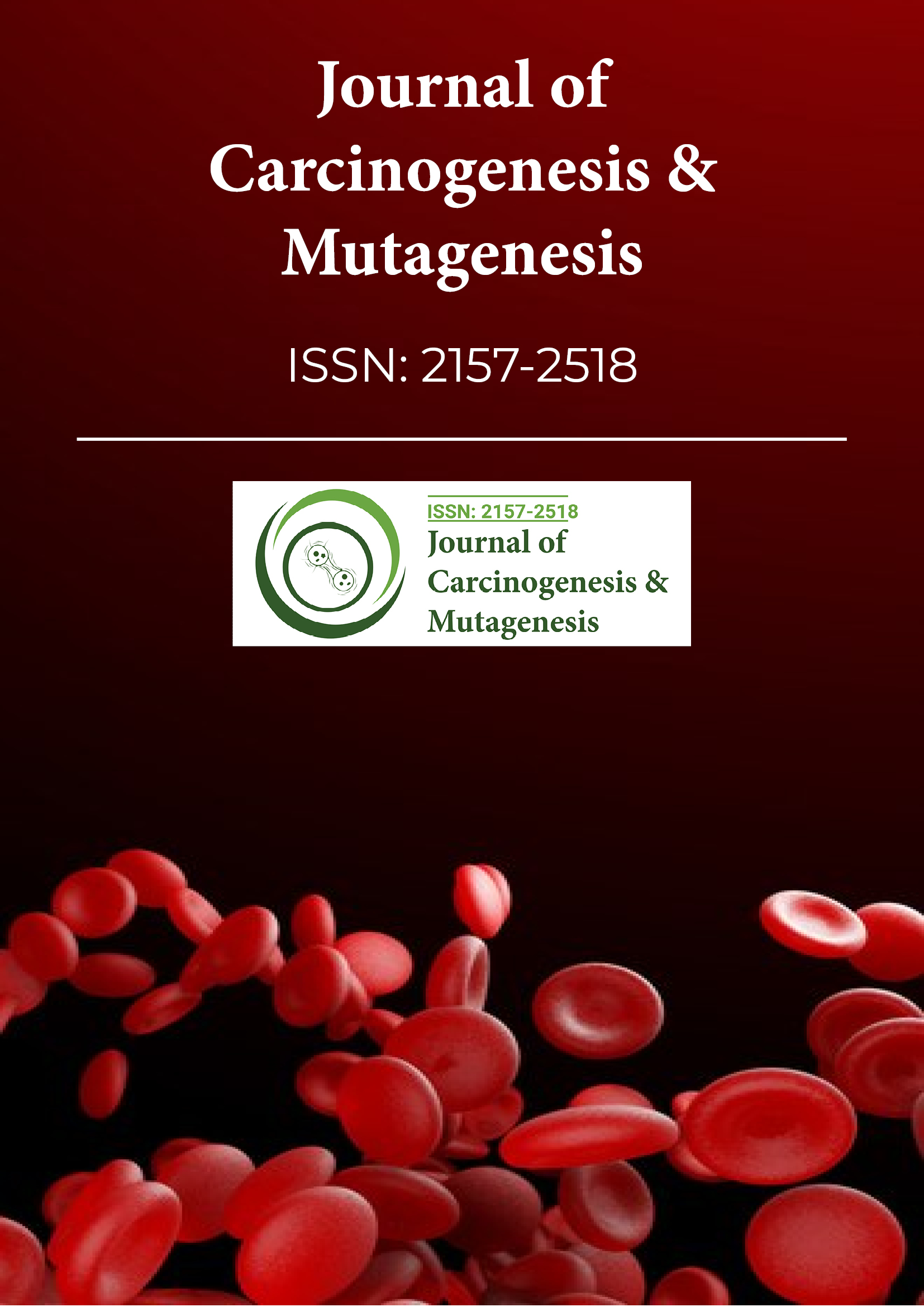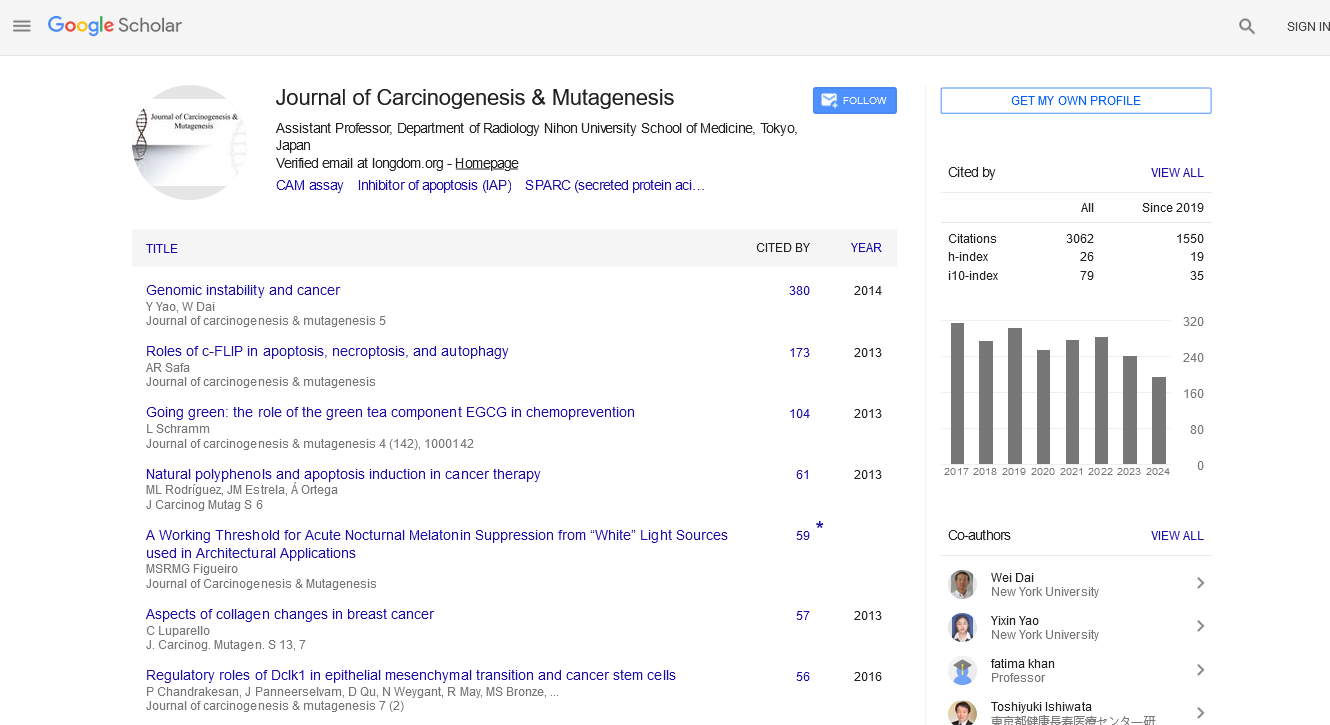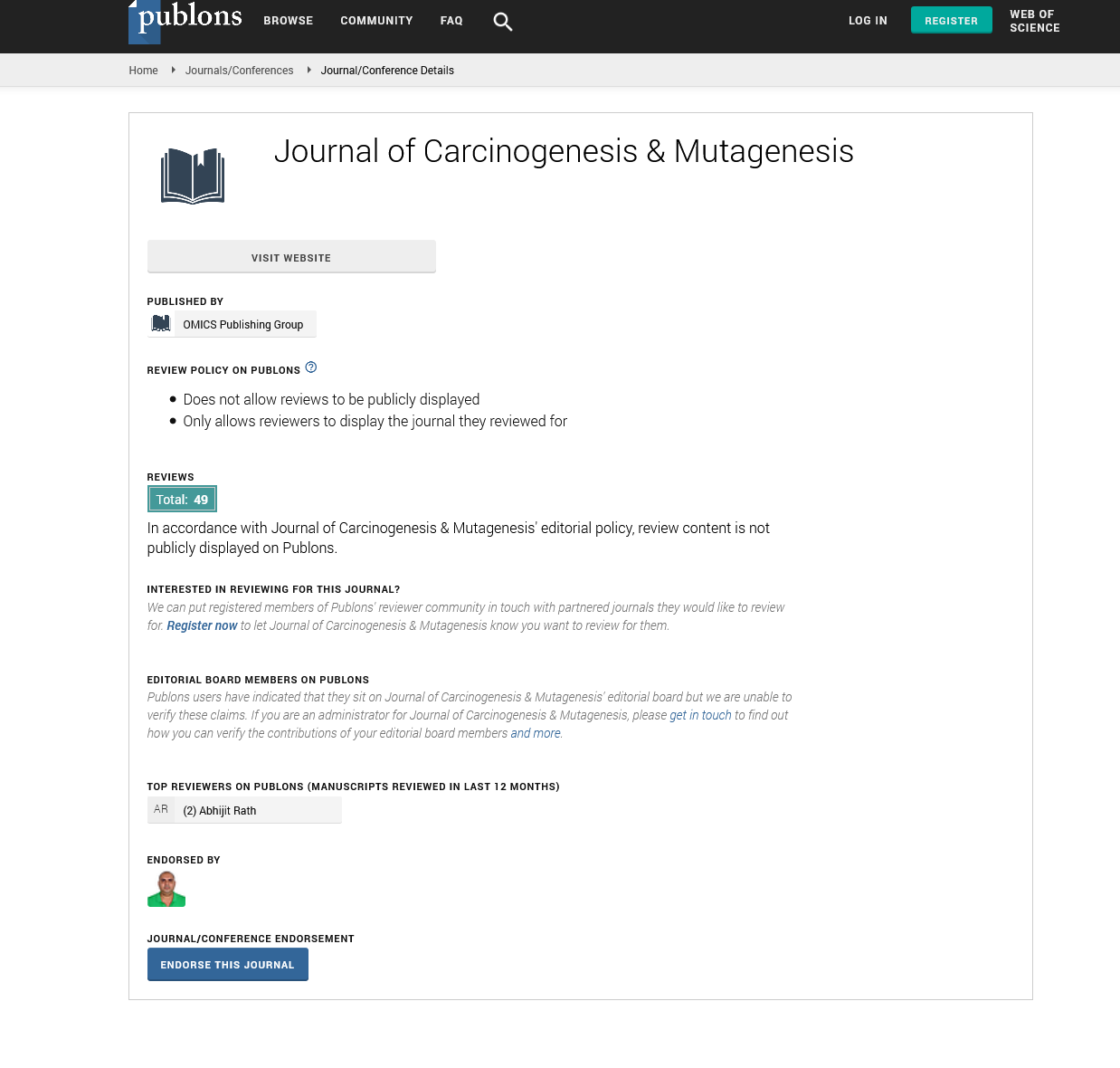Indexed In
- Open J Gate
- Genamics JournalSeek
- JournalTOCs
- Ulrich's Periodicals Directory
- RefSeek
- Hamdard University
- EBSCO A-Z
- OCLC- WorldCat
- Publons
- Geneva Foundation for Medical Education and Research
- Euro Pub
- Google Scholar
Useful Links
Share This Page
Journal Flyer

Open Access Journals
- Agri and Aquaculture
- Biochemistry
- Bioinformatics & Systems Biology
- Business & Management
- Chemistry
- Clinical Sciences
- Engineering
- Food & Nutrition
- General Science
- Genetics & Molecular Biology
- Immunology & Microbiology
- Medical Sciences
- Neuroscience & Psychology
- Nursing & Health Care
- Pharmaceutical Sciences
Short Communication - (2024) Volume 15, Issue 6
MUC13: Unraveling Its Oncogenic Functions in Cancer Progression
Shabnam Malik and Subhash C Chauhan*Received: 20-Nov-2024, Manuscript No. JCM-24-27557; Editor assigned: 22-Nov-2024, Pre QC No. JCM-24-27557 (PQ); Reviewed: 06-Dec-2024, QC No. JCM-24-27557; Revised: 13-Dec-2024, Manuscript No. JCM-24-27557 (R); Published: 20-Dec-2024, DOI: 10.35248/2157-2518.2.15.461
About the Study
Mucin 13 (MUC13) is a transmembrane glycoprotein that plays a pivotal role in cell signaling and interactions within the tumor microenvironment. Research indicates that MUC13 acts as an oncogenic factor in various cancers, including pancreatic, ovarian, breast, and colon cancers, where its increased expression promotes the development of a dense mucin-rich extracellular matrix that enhances tumor growth, invasion, and metastasis [1,2]. This communication aims to summarize the current understanding of MUC13's structure and expression, as well as its significant role in oncogenesis.
MUC13 structure and expression
The extracellular tandem repeat domain of MUC13 is highly glycosylated, contributing to the anti-adhesive properties of cancer cells [1]. It also contains a cytoplasmic domain with potential phosphorylation sites, along with three Epidermal Growth Factors (EGF) domains. Recently, our laboratory reported that MUC13 genomic transcripts consist of two protein variants: short MUC13 (s-MUC13), which is non-tumorigenic, and long MUC13 (L-MUC13), which is tumorigenic and contains several critical phosphorylation sites. Notably, the presence of long form of MUC13 could be a key factor driving its tumorigenic effects, solidifying its significance as a potential oncogene [3]. MUC13 prompted notable biophysical changes in pancreatic cancer cells, as previously demonstrated in our laboratory's studies [4]. This study provides valuable insights into the application of biophysical measurements for the diagnosis and monitoring of cancer, as well as for assessing the mechanical impact of genetic alterations. Furthermore, its potential as a biomarker for cancer and other disorders is emphasized by abnormal expression patterns observed in various malignancies, which are linked to aggressive cancer characteristics [1]. The mechanisms underlying MUC13 overexpression are actively being investigated, with emerging evidence suggesting involvement of epigenetic modifications and transcriptional regulation influenced by oncogenic signals.
Role in cell migration and invasion
MUC13 plays a pivotal role in enhancing cellular motility and invasiveness, features that are critical for the metastasis of various cancers. In pancreatic cancer specifically, elevated MUC13 expression has been associated with the enhanced migration of cancer cells, characterized by the formation of cellular projections essential for movement. Findings suggest that MUC13 mediates these processes through the modulation of the actin cytoskeleton, enabling robust interactions with cytoskeletal proteins to promote cell motility. Our research highlights the influence of MUC13 on pancreatic cancer growth through the modulation of proteins PAK1 and S100A4 [5]. In the context of ovarian cancer, MUC13 overexpression has been linked to decreased cell-cell interactions and increased migration, which is accompanied by notable reconfiguration of F-actin. Specifically, the localization of MUC13 in the basal region and along the basement membrane in ovarian cancer cells facilitates their detachment from the primary tumor and promotes invasion into surrounding stromal tissue [2]. These findings strongly suggest a direct correlation between MUC13 and enhanced cellular motility. Research indicates that MUC13- mediated alterations in cell adhesion properties can significantly promote cancer invasion and propagation [2].
MUC13 and key signaling pathways
Emerging studies indicate a significant association between MUC13 expression and tumor differentiation, particularly emphasizing its upregulation in various cancers. It has been reported that MUC13 may act as a ligand for HER2, activating critical oncogenic signaling pathways that drive pancreatic cancer progression [1]. Another study showed that the c-Myc and cyclin D oncogenes, downstream effectors of the Wnt/β-catenin signaling pathway, were positively correlated with MUC13 levels [6]. Moreover, our laboratory has explored MUC13's functionality in ovarian cancer, finding a direct link between MUC13 expression and the disease [2,7]. MUC13 is consistently expressed at elevated levels and shows abnormal localization in colon cancer tissues, indicating its potential role in the disease's pathogenesis. Our research highlights that these elevated levels may influence cellular signaling pathways, particularly the JAK2/STAT5 pathway, which could promote tumor growth and progression [8]. In renal cancer, elevated MUC13 expression correlates positively with increased Fuhrman grade pathological grading system for renal cell carcinomas and poor overall survival rates [1]. We have identified a novel role of MUC13 in the metabolic reprogramming of pancreatic cancer, demonstrating its influence on cancer cell metabolism and the key molecular pathways that contribute to tumorigenic traits. The study reveals a significant correlation between MUC13 and Glut-1 in patient tissue samples. Although further research is needed, the findings suggest that the cytoplasmic domain of MUC13 may interact with Glut-1, indicating a potential role in cell signaling [9]. Our recent research has shown that MUC13 increases resistance to anoikis by forming a survival complex with YAP1, promoting its movement into the nucleus, and upregulating the expression of pro-survival and metastasis related genes in colon cancer. This highlights MUC13 as a potential therapeutic target for metastatic disease [10].
Clinical implications and future directions
In conclusion, MUC13 serves as a promising oncogenic target across multiple malignancies, emphasizing the need for further investigation into therapeutic strategies that incorporate both CAR T cell therapy and vaccine development to modulate its expression and activity. Recognizing MUC13's involvement in cancer progression opens up innovative avenues for diagnostic and therapeutic applications, particularly the design of MUC13- targeted vaccines and CAR T cells that specifically recognize and attack MUC13-expressing tumor cells. By focusing on MUC13 and its associated signaling pathways, we can develop approaches that not only inhibit cancer cell migration and reduce metastatic spread but also bolster the immune response against tumors. Ongoing research is vital to elucidate the precise mechanisms through which MUC13 orchestrates oncogenic signaling, as well as to identify potential small molecules or antibodies that can inhibit its function, thereby creating new opportunities for enhancing cancer immunotherapy through CAR T cell strategies and vaccine initiatives.
References
- Malik S, Sikander M, Wahid M, Dhasmana A, Sarwat M, Khan S, et al. Deciphering cellular and molecular mechanism of MUC13 mucin involved in cancer cell plasticity and drug resistance. Cancer Metastasis Rev. 2024;43(3):981-999.
[Crossref] [Google Scholar] [PubMed]
- Malik S, Sikander M, Bell N, Zubieta D, Bell MC, Yallapu MM, et al. Emerging role of mucins in antibody drug conjugates for ovarian cancer therapy. J Ovarian Res. 2024;17(1):161.
[Crossref] [Google Scholar] [PubMed]
- Dhasmana A, Dhasmana S, Agarwal S, Khan S, Haque S, Jaggi M, et al. Integrative big transcriptomics data analysis implicates crucial role of MUC13 in pancreatic cancer. Comput Struct Biotechnol J. 2023;21:2845-2857.
[Crossref] [Google Scholar] [PubMed]
- Massey AE, Doxtater K, Yallapu MM, Chauhan SC, et al. Biophysical changes caused by altered MUC13 expression in pancreatic cancer cells. Micron. 2020;130:102822.
[Crossref] [Google Scholar] [PubMed]
- Chauhan SC, Ebeling MC, Maher DM, Koch MD, Watanabe A, Aburatani H, et al. MUC13 mucin augments pancreatic tumorigenesis. Mol Cancer Ther. 2012;11(1):24-33.
[Crossref] [Google Scholar] [PubMed]
- Dai Y, Liu L, Zeng T, Liang JZ, Song Y, Chen K, et al. Overexpression of MUC13, a Poor Prognostic Predictor, Promotes Cell Growth by Activating Wnt Signaling in Hepatocellular Carcinoma. Am J Pathol. 2018;188(2):378-391.
[Crossref] [Google Scholar] [PubMed]
- Chauhan SC, Vannatta K, Ebeling MC, Vinayek N, Watanabe A, Pandey KK, et al. Expression and functions of transmembrane mucin MUC13 in ovarian cancer. Cancer Res. 2009;69(3):765-74.
[Crossref] [Google Scholar] [PubMed]
- Gupta BK, Maher DM, Ebeling MC, Stephenson PD, Puumala SE, Koch MR, et al. Functions and regulation of MUC13 mucin in colon cancer cells. J Gastroenterol. 2014;49(10):1378-91.
[Crossref] [Google Scholar] [PubMed]
- Kumari S, Khan S, Gupta SC, Kashyap VK, Yallapu MM, Chauhan SC, et al. MUC13 contributes to rewiring of glucose metabolism in pancreatic cancer. Oncogenesis. 2018;7(2):19.
[Crossref] [Google Scholar] [PubMed]
- Doxtater K. MUC13 drives cancer aggressiveness and metastasis through the YAP1-dependent pathway. Life Sci Alliance. 2023;6(12): e202301975.
[Crossref] [Google Scholar] [PubMed]
Citation: Malik S, Chauhan SC (2024). MUC13: Unraveling Its Oncogenic Functions in Cancer Progression. J Carcinog Mutagen. 15:461.
Copyright: © 2024 Malik S, et al. This is an open-access article distributed under the terms of the Creative Commons Attribution License, which permits unrestricted use, distribution, and reproduction in any medium, provided the original author and source are credited.


